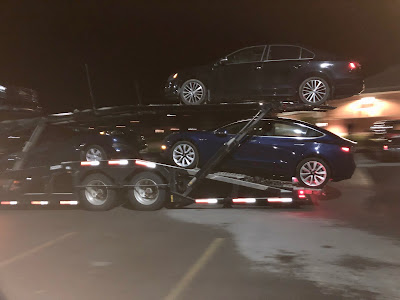Like the smartphone, the Tesla operating system is updated from time to time with unprecedented results.
Consumer Reports did a review of the Model 3 a few months ago. They liked the car for the most part but found that the braking distance was unacceptably long for a car of its class. Tesla, however, did something that no other car company could do. Within a couple of days the company prepared a software update that was delivered over the air that corrected flaws in the car's computerized ABS system. Consumer Reports then gave the car a recommended rating.
This is just one example of the way that Tesla has rethought the car. All Teslas have an always on LTE cellular service. This way the company can deliver regular software updates that can add functions and incorporate suggestions from customers. An early example was the addition of the "creep" mode that simulates the operation of an automatic transmission car when the driver takes his/her foot off the gas from a stop. I myself don't miss creeping at all!
These updates also add functionality to the Autopilot system. In the few weeks that we have had our car Blue there have been about four software updates (although I think we are about three behind for some reason). These updates are not all farts, romance mode and new Atari games. They include genuine and important improvements to the functioning of the car.
 |
| Release Notes for a Tesla Software Update |
It is easy to predict that other manufacturers will adopt similar over the air updates, but as with many innovations that others will copy, Tesla was there first.
As many Tesla owners observe, their car just keeps getting better, and since nearly all functions are controlled by the car's computer(s) nearly all functions can improve over time. Sadly, software alone can't heat the steering wheel or add a heads up display!
However, the real promise of the Tesla approach will come when its already promising Autopilot software evolves towards true autonomous driving. It seems that this will not come in a single massive update but will come to Tesla owners incrementally as Autopilot functions are enhanced and less and less human intervention is required. Elon Musk stated some time ago that all Teslas would now be built with the hardware that would enable full self-driving ability, although there was a subsequent announcement of a computer update to take full advantage of this ability.
We already have Summon, which enables limited control of the car from outside the car. It is guaranteed to make non-Tesla folks freak out. This function will in due course enable more complex manoeuvers of the car in the complete absence of a driver.
The Tesla audio system is already good but I can see it being enhanced with the availability of Apple Music or Spotify with a simple over the air update. The current built-in streaming service, Slacker, is OK in a pinch but limited. In fact, subject to hardware limitations, the possibilities for ongoing improvement of the user interface and driving and control functions of the car is virtually unlimited. I can imagine new traction control settings or settings for mud and sand as you get in some off-road vehicles for example.
Another technical innovation is the integration with a smartphone although to some degree other manufacturers are picking up on this idea. None of them, however, can match the range of functions already available with the Tesla app, let alone what will be coming in future.
I have mentioned Teslafi.com, a paid website that can access the data from the car and produces in awesome detail a report of where you have been, how fast you were going, how much charge you used and just about every other variable imaginable. It is awesome.
At the same time, all of this raises some sinister issues. If my car is always sending information out into the ether, how can I be sure that it is only being received in accordance with my wishes? I assume that Tesla has access to all of this information and that somewhere along the way I signed a user agreement giving them that access, even though I don't recall it specifically. There are serious privacy concerns. Can I be tracked through my car? Can I one day be charged with speeding because of data from my car? Could a hacker corrupt the operating system of my car and cause it to crash?
The truth is, we have little idea how vulnerable our Tesla cars might be to the guys wearing black hats. The problem will be even more serious in the relatively near future. In introducing its semi truck, Tesla predicted convoys of autonomous trucks following a lead vehicle. If the connection among all these vehicles is broken or corrupted, what kind of chaos could result? In time we can envision a rush hour in which all cars are autonomously driving a few inches apart, moving in unison like a flock of birds.
Can we really put our faith in the software and hardware that will give us full autonomous driving? For now I enjoy the limited driver assistance of Autopilot, but I am still the driver. But will we have to start worrying about firewalls and virus protection for our cars?







